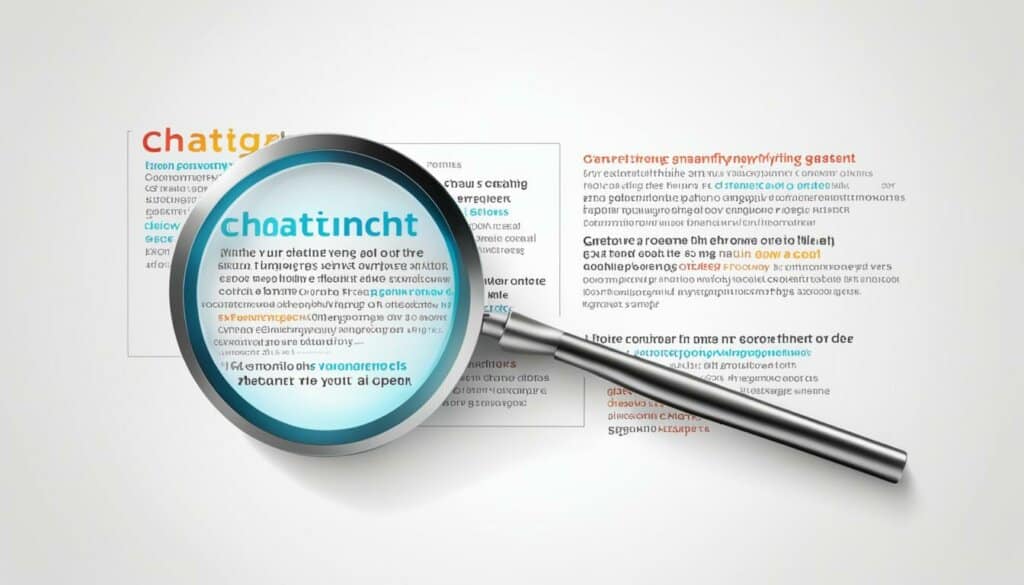Table of Contents
ChatGPT has become a popular tool for writing content, but there is a need to detect whether a text has been written by ChatGPT or a human. As AI continues to advance, it is important to identify ChatGPT-generated content to maintain academic integrity and quality standards.
So, how can you tell if ChatGPT has written something? There are several signs that can help you detect ChatGPT’s involvement in text creation. One of the key indicators is the presence of false information. ChatGPT, while trained to sound plausible, may provide inaccurate or misleading facts.
Another sign is the occurrence of nonsensical sentences. ChatGPT’s algorithm may generate sentences that are grammatically correct but lack coherent meaning. These nonsensical sentences can be a clear indication of AI-generated content.
On the other hand, logical and cohesive sentences with an overuse of transitional words can also point towards ChatGPT’s handiwork. Unlike humans, who often use natural language variations, ChatGPT tends to be overly logical and makes excessive use of connector words.
One way to confirm ChatGPT’s involvement is by asking it to create a similar piece of content. By providing specific instructions and structure, you can compare the generated content with the original text to identify any similarities or patterns.
Another approach is to utilize AI detection tools. These tools employ algorithms and machine learning models to analyze and compare texts for AI involvement. OpenAI’s AI Text Classifier, Turnitin, Content At Scale, Originality AI, and GPTZero are popular tools used for detecting ChatGPT-generated content.
However, it is essential to acknowledge the limitations of these tools. While they can assist in identifying AI-generated content, they are not foolproof. AI detection tools may have accuracy issues, mistakenly classifying human-generated text as AI-generated and struggling with translated or paraphrased content.
To use ChatGPT in a safe and ethical manner, it is important to familiarize yourself with the limitations of detection methods. Additionally, customize and revise the generated content, use diverse sources, provide proper citation and referencing, and thoroughly proofread the final text to ensure accuracy and maintain academic integrity.
In conclusion, detecting ChatGPT’s handiwork in text creation is possible through various signs and AI detection tools. By staying aware of advancements in AI technology and continuously adapting detection methods, we can accurately identify ChatGPT-generated content and uphold high standards in content creation and academia.
Signs of ChatGPT’s Involvement
When examining a text for the presence of ChatGPT’s involvement, there are several signs to watch out for. False information is a prominent characteristic of ChatGPT-generated content. As an AI model, ChatGPT aims to provide answers that sound plausible, even if they are not entirely accurate.
Nonsensical sentences can also indicate the contribution of ChatGPT. While these sentences may be grammatically correct, they lack coherence and meaning. This can be a clear indication of AI-generated content.
Furthermore, highly logical and cohesive sentences with an overuse of transitional words can raise suspicions about the text’s origin. ChatGPT tends to produce texts that are overly structured and almost too perfect, lacking the natural variations and idiosyncrasies of human writing.
For instance, a nonsensical sentence generated by ChatGPT might look like this: “The purple monkeys danced gracefully on the floating unicorn.” While the individual words may make sense on their own, when combined, they create an illogical and nonsensical sentence.
Examples of Nonsensical Sentences:
1. The sunflowers sang harmoniously with the buzzing donuts.
2. He hugged the moon and whispered secrets to the sparkling stars.
3. The teapot sneezed and stripes appeared on the wallpaper.
To highlight the signs of ChatGPT’s involvement, consider a comparison between AI-generated text and human-written text. By inspecting the content, language patterns, and logical flow, you can discern the fingerprints of ChatGPT’s influence.
However, it’s essential to remember that while these signs can be indicative of ChatGPT’s involvement, they are not foolproof. AI technology continues to advance, and there may be instances where it becomes more challenging to detect AI-generated content accurately.
Let’s explore in further detail how you can ask ChatGPT to create similar content to verify its involvement in Section 3.
Ask ChatGPT for Similar Content
If you suspect that a text has been written by ChatGPT, you can directly engage with the AI model to create a similar piece of content. By requesting specific instructions and structure, you can compare the generated content to the original text and verify whether ChatGPT was involved in its creation.
Asking ChatGPT to generate similar content allows you to observe its writing style, approach to sentence construction, and the presence of any AI-driven patterns. By analyzing the output, you can gain insights into whether the original text bears resemblance to ChatGPT’s handiwork.
Here’s an example of how you can interact with ChatGPT to create similar content:
You: “ChatGPT, please create a blog post on the benefits of exercise for overall well-being. Include key points on physical health, mental health, and longevity.”
ChatGPT: “Regular exercise offers numerous benefits for overall well-being. It improves cardiovascular health, builds strength and endurance, reduces the risk of chronic diseases, boosts mood and cognitive function, promotes better sleep, and increases life expectancy.”
After generating a response, carefully compare it to the original text to identify any similarities or stylistic overlaps that may indicate ChatGPT’s involvement. Pay attention to factors such as word choice, sentence structure, and coherence to determine the likelihood of AI-generated content.
Table below summarizes the steps for asking ChatGPT for similar content:
| Steps: | Instructions: |
|---|---|
| Step 1 | Prepare specific instructions and structure for the content you want ChatGPT to create. |
| Step 2 | Engage with ChatGPT by providing your instructions. |
| Step 3 | Receive the generated content from ChatGPT. |
| Step 4 | Compare the generated content to the original text for similarities and AI-driven patterns. |
By following these steps, you can effectively assess whether ChatGPT played a role in the creation of a specific text.

Using AI Detection Tools
When it comes to detecting ChatGPT-generated content, AI detection tools play a vital role. These advanced tools leverage powerful algorithms and machine learning models to analyze and compare texts, enabling the identification of AI involvement. If you suspect that a text may have been generated by ChatGPT, these tools can provide valuable insight.
One notable AI detection tool is OpenAI’s AI Text Classifier, designed specifically to detect AI-generated text. It has been extensively trained on a diverse range of datasets and can accurately identify the language patterns and characteristics associated with ChatGPT. Additionally, Turnitin, a popular plagiarism detection software, is also effective in recognizing ChatGPT-generated content.
Content At Scale is another highly regarded tool that uses advanced AI techniques to identify AI-generated text. Their comprehensive approach incorporates multiple detection methods, providing reliable results. Originality AI is a specialized tool that focuses on detecting plagiarism and AI involvement in text creation.
“AI detection tools are invaluable for identifying ChatGPT-generated content. These tools empower users to differentiate between human-written and AI-generated text, ensuring academic integrity and maintaining high standards of originality.”
In addition to the aforementioned tools, GPTZero is a comprehensive detection framework that employs machine learning models to analyze and identify AI-generated content. By training on large datasets, GPTZero is capable of delivering accurate detection results.
It is important to note that the effectiveness of AI detection tools may vary depending on the specific context and the sophistication of the AI model. Therefore, it is advisable to utilize a combination of different detection tools to enhance accuracy and reliability.
Pros and Cons of AI Detection Tools
Let’s take a closer look at the advantages and limitations of using AI detection tools:
| Pros | Cons |
|---|---|
|
|
While AI detection tools offer significant advantages in identifying ChatGPT-generated content, their limitations must be considered. Users should exercise caution and complement their usage with critical thinking and manual review to ensure accurate identification.
Limitations of AI Detection Tools
While AI detection tools can be helpful in identifying ChatGPT-generated content, it is important to acknowledge their limitations. These tools may not always provide foolproof accuracy and can occasionally misclassify human-generated text as AI-generated. Moreover, AI detection tools may encounter challenges in detecting content that has been translated or paraphrased. It is crucial to consider these limitations when relying on AI detection tools for identifying ChatGPT-generated text.
Tips for Safely Using ChatGPT
In order to utilize ChatGPT effectively while avoiding detection and maintaining academic integrity, there are several important tips to keep in mind:
- Understand the Limitations of Detection Methods: It is crucial to be aware that detection methods for identifying ChatGPT-generated content may not always be foolproof. Familiarize yourself with the shortcomings and potential inaccuracies of these tools to make informed decisions.
- Customize and Revise Generated Content: To enhance the authenticity of ChatGPT-generated text, customize and revise the content to align with your style and context. Add personal touches, tweak sentence structures, and inject unique perspectives to avoid generating content that appears generic or suspicious.
- Use Diverse Sources: When using ChatGPT, it is important to gather information from various sources instead of relying solely on the AI model. Incorporating insights from authoritative and credible references ensures a well-rounded and trustworthy final output.
- Provide Proper Citation and Referencing: When using ideas, quotes, or information from external sources, make sure to explicitly cite and reference them in your content. Accurate citation and referencing demonstrate academic integrity and help avoid potential plagiarism issues.
- Thoroughly Proofread the Final Text: Always review and proofread the text generated by ChatGPT before publishing or sharing it. Look for any grammatical errors, ambiguous statements, or inconsistent information that could raise suspicion or compromise the quality of your content.
By following these tips, you can safely leverage ChatGPT’s capabilities while minimizing the risk of detection and maintaining academic integrity.
Conclusion
Detecting ChatGPT’s handiwork in text creation is crucial in today’s digital landscape where AI-generated content is increasingly prevalent. By leveraging various signs and AI detection tools, it is possible to identify when a text has been written by ChatGPT rather than a human. These methods serve as effective mechanisms in ensuring academic integrity and distinguishing between human-written and AI-generated content.
While these detection methods are valuable, it is important to recognize their limitations. AI detection tools, although powerful, can sometimes misclassify human-written text as AI-generated and may struggle with translated or paraphrased content. Therefore, it is necessary to exercise caution and not solely rely on these tools.
Staying informed about advancements in AI technology and continuously adapting detection methods are essential practices. The landscape of AI-generated content is ever-evolving, and by keeping up with the latest developments in detection techniques, we can enhance our ability to accurately identify ChatGPT-generated text.
In conclusion, understanding the signs of ChatGPT’s involvement, utilizing AI detection tools, and staying updated on AI advancements are key strategies to effectively identify AI-generated content. By employing these methods, we can uphold academic integrity, maintain transparency, and confidently discern between human-written and ChatGPT-generated text.
FAQ
How can I tell if a text has been written by ChatGPT?
There are several signs that can indicate AI-generated content, such as false information, nonsensical sentences, logical and cohesive sentences, and the absence of grammatical or spelling mistakes. By asking ChatGPT to create a similar piece of content, one can also confirm its involvement in writing the text.
What are the signs of ChatGPT’s involvement in text creation?
False information is a common characteristic of ChatGPT-generated content, as the AI model prioritizes providing plausible-sounding answers. Nonsensical sentences, which may be grammatically correct but lack meaning, can also indicate the involvement of ChatGPT. Additionally, highly logical and cohesive sentences with an overuse of transitional words can be a clear sign that the text is AI-generated.
How can I verify if a text is ChatGPT-generated?
If there is suspicion that a text has been written by ChatGPT, one can ask ChatGPT itself to create a similar piece of content. By providing specific instructions and structure, the generated content can be compared to the original text to confirm whether ChatGPT was involved in its creation.
Are there any AI tools that can help detect ChatGPT-generated content?
Yes, there are AI detection tools that can be used to identify ChatGPT-generated content. These tools utilize algorithms and machine learning models to analyze and compare texts for AI involvement. Some popular AI detection tools include OpenAI’s AI Text Classifier, Turnitin, Content At Scale, Originality AI, and GPTZero.
What are the limitations of AI detection tools in identifying ChatGPT-generated content?
While AI detection tools can be helpful in identifying ChatGPT-generated content, they are not foolproof. These tools may not always be accurate and can mistakenly classify human-generated text as AI-generated. Additionally, AI detection tools may struggle to detect content that has been translated or paraphrased. It is important to consider the limitations of these tools when relying on them for detection.
How can I safely use ChatGPT without raising red flags or compromising academic integrity?
To use ChatGPT without raising red flags or compromising academic integrity, it is important to understand the limitations of detection methods, customize and revise generated content, use diverse sources, provide proper citation and referencing, and thoroughly proofread the final text.
How can I accurately identify ChatGPT-generated text?
Detecting ChatGPT’s handiwork in text creation is possible through various signs and AI detection tools. While these methods have their limitations, they can be valuable in maintaining academic integrity and discerning between human-written and AI-generated content. It is important to stay aware of advancements in AI technology and continuously adapt detection methods to ensure accurate identification of ChatGPT-generated text.







